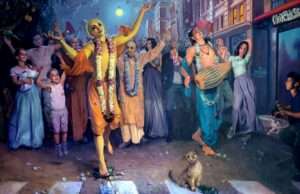It is written in the Visnu-rahasya:
yad abhyarcya harim bhaktya
krte kratu-satair api
phalam prapnoty avikalam
kalau govinda-kirtanat
Whatever fruit is obtainable in Satya-yuga, worshiping Sri Hari with devotion by performing hundreds of sacrifices, in Kali-yuga the same result is attainable simply with Govinda kirtana.
While the holy names are chanted, other methods of purification are prohibited. It is written in the Brhad-visnu Purana:
namno ‘sya yavati saktih
papa-nirharane hareh
tavat kartum na saknoti
patakam pataki janah
By simply chanting the name of Hari once, a man engaged in sinful activities is able to counter the reactions of more sins than he can commit.
There is no purification that equals the chanting of the holy names. Intelligent people, therefore, abandon all duties mentioned in the Vedas.
Regarding the supremacy of kirtana, in Hari-bhakti-vilasa there is the following quote from Vaisnava-cintamani:
aghacchit smaranam visnor
bahvayasena sadhyate
ostha-spandana-matrena
kirtanan tu tato varam
The remembrance of Visnu, who destroys all sins, is attainable after great efforts, but the glorification of Visnu – simply by vibrating the lips – is superior to remembrance. (The reason is that even with namabhasa, that is, with the reflection of chanting, the chains of the material world are broken.)
Remembrance of the Lord is difficult to obtain by carrying out austerities. Kirtana, on the other hand, is feasible simply with the movement of the lips. Even by not moving the lips one can remember the holy names. Absolute perfection is attainable through singing and remembering. All the sastras therefore establish that the remembrance and chanting of the holy names are superior to the method of the arcana.
The Hari-bhakti-vilasa declares:
yena janma-sataih purvam
vasudevah samarcitah
tan mukhe hari-namani
sada tisthanti bharata
Oh best of the Bharatas! The holy name of Hari is present only on the lips of those who have perfectly adored Vasudeva for hundreds of past births.
The sixteen words of the Hare Krishna mantra make up eight pairs of names. Caitanya Mahaprabhu recited the eight slokas of the Siksastaka, referring to them.
The first pair of names – Hare Krishna – means the conqueror of ignorance and the faith-based execution of nama-sankirtana.
The second pair – Hare Krishna – means that Krishna’s holy names are endowed with all powers. One should develop attachment to bhajana by taking refuge in holy names by associating with sadhus. By practicing bhajana, gradually, the anarthas (unwanted defilements) are destroyed. When the anarthas are removed, nistha (firm faith) develops.
The third pair – Krishna Krishna – signifies the company of pure devotees and having settled in firm faith all day and night.
The fourth pair – Hare Hare – awakens selfless devotion and a taste for nama-sankirtana.
The fifth pair – Hare Rama – represents the taste for pure devotional service together with the remembrance of the holy names according to the prescription of the Siksastaka.
The sixth pair – Hare Rama – that is, chanting on the initial level of transcendental emotion, leads to detachment from the material and complete attachment to Krishna.
The seventh couple – Rama Rama – awakens attachment to the sweetness of marital rasa, the refuge at Radha’s lotus feet and feelings of separation.
The eighth pair – Hare Hare – leads to the attainment of the purpose of life – loving service to Radha and Krishna by following the feelings of the gopis of Vrndavana, during the eight divisions of day and night (asta-kala).
This is a section of the book “Bhajana Rahasya”, by Bhaktivinode Thakura.
To buy the complete book, click above
Post view 447 times




Leave a Reply